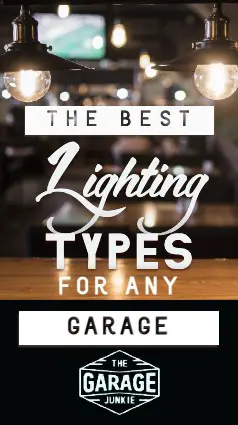When you think of the quality of lighting in your garage, most people would probably describe it as a dim, uninviting environment akin to the average Law & Order interrogation scene. This is because most garages employ utilitarian florescent lighting. But it doesn’t have to be this way.
With just a little bit of effort you can have your garage set up with lighting fixtures that are more than just functional but inviting as well. And this is something that every garage owner should prioritize, as a dimly lit garage can lead to an unsafe environment rife for injuries.
But how can you tell what type and how much light will be suitable for your garage’s space? Well, the answer is easier to ascertain than you might first think.
Brightness for Standard Garage Lighting
According to noted home expert Bob Vila, a typical garage with a workshop will need lighting that is capable of producing at least 3500 lumens. Lumens (if you don’t know) is the standard by which the industry measures the brightness that lighting can produce. It is worth noting that this is a different number from the watts you may see listed on a bulb’s package. For example, a typical 75-watt lightbulb will produce about 1100 lumens worth of light, or brightness.
There are a variety of factors to consider when outfitting your own garage with new lighting, but have no fear, below we will look at different types of common lighting fixtures and types of bulbs, and discuss how to tell what the best option is for you and your space.

Florescent Vs. LEDs: Which One is Best for Your Garage?
Florescent Lighting
The most common style of garage lighting is florescent tube lighting. This type of lighting is usually installed in overhead fixtures and should be familiar to anyone from office workers to school children. While florescent bulbs have a few advantages over conventional incandescent bulbs, mainly price and durability, there are a few drawbacks that everyone should be aware of:
- Florescent bulbs can produce harsher light when compared to other lighting options.
- If you live in a colder climate, Florescent bulbs can have trouble functioning properly when the temperature drops below 50 degrees Fahrenheit.
- Florescent bulbs produce light that brings out cooler colors which may not be suitable if you do work in your garage that requires you to see colors truly.
LED Lighting
When looking at LED lighting in comparison, you will get many of the same benefits you would enjoy with florescent lighting, often to an even further extent. So, while florescent lights can last roughly 10 times as long as an incandescent bulb, good LEDs can last up to 30 times longer. However, it is good to keep the following in mind when considering LED lights for your garage:
- LEDs are actually more energy efficient in colder temperatures, but they lose this advantage when compared to florescent lights in warmer temperatures.
- A typical LED fixture will last over 10,000 hours (or 27 years of continuous use), but once they have reached the end of their life cycle, LED bulbs cannot be as easily replaced as bulbs from florescent or incandescent fixtures are.
Different Types of Lighting Fixtures
Aside from overhead lighting, most garage owners will find they require additional light sources specific to their own needs and space. This can include lighting options such as:
Clamp-on lights:
Clamp-ons are a great type of light if you will need lighting that is portable and can be easily moved around to different stations or areas of your garage. This type of light can come in both LED and florescent options, and the best part is they can usually be easily packed away and stored when not in use.
Task Lights:
This type of lighting will produce a focused amount of light that is ideal for those who work on projects in their garage. Whether you do laundry or woodworking in your garage, having ample light to complete tasks can make all the difference. Just be sure to position your light so that it doesn’t shine in your eyes, create shadows, or otherwise impede your ability to focus on the task at hand.
Cabinet Lights:
If you often find yourself straining your eyes while rummaging through darkened cabinets in your garage with little success of finding what you are looking for, consider adding cabinet lights to help brighten these areas. The easiest option will probably be LEDs as they can be installed and run off of battery power and come in a variety of color temperatures.
Installation Considerations
Before installing any lighting fixtures, it is important to first get a clear idea of your garage’s space and lighting needs as this will inform where fixtures should be installed. Knowing what specific type of lighting you need and plan on using will make installation much easier later on.
The easiest type of lighting upgrade for most garages is to use lightbulbs that can be easily screwed into your existing light sockets or simply plugged into an available wall outlet. However, if you are considering upgrading to florescent lighting, you should know that they require a more thorough installation. This typically involves wiring them to your garage’s main circuit breaker. Doing so isn’t a terribly labor-intensive process; however it is necessary, thanks to the regulator most florescent light fixtures use, to keep too much electricity from reaching the lightbulbs and blowing them out. For this reason, you may look to a professional electrician for help or guidance during your installation.
Our Top Picks for Lighting Your Garage
In conclusion, by now we hope you can see the clear benefits to upgrading your garage’s lighting system. Not only will new lights be more energy efficient, saving you money in the long run, but they also can be better calibrated to your space’s true needs. Most options can easily be installed without any advanced knowledge of electrical wiring required and doing so may only require a few minutes to complete.
Easiest to Install LED Overhead Light:
Adjustable Tri-bright Garage Ceiling Lightbulb by Qimedo
This is a great LED lighting option that produces a substantial amount of light and can easily be installed by simply screwing it into a typical E26 or E27 lightbulb socket. Each of the three light panels is fully adjustable so you can ensure even light coverage and do away with any troubling dark spots your garage may normally contain.
Best Bang for Your Buck:
Barrina LED T5 Integrated Single Fixture
These LEDs are great for providing a TON of lumens (2200 lumens each!) for a very reasonable price. They can be easily installed by plugging them into a standard wall outlet and daisy chaining individual bulbs together with the included cords. Comes with easily installed snap joints that makes installation a breeze. Best yet, you’ll save money every time you use them as these lights sip electricity at a minimal 20 Watts.
Best Shop Area Light:
The most important factor to consider when choosing a shop light is the ability to be hung closer to your workspace. This is because you will want the maximum amount of light with a minimal amount of shadow and hanging lights over your workspace is a nearly foolproof way to ensure this. These LED shop lights from hykolity are great for this reason in addition to being plenty bright and easily switched on and off.
Best Florescent Lighting:
Lithonia Lighting C 240 120 MBE 2INKO
If you are looking to replace older florescent lighting you may already have installed in your garage, look no further than this model from Lithonia Lighting. These florescent light fixtures are ideal for upgrading to as they can handle any standard four-foot T12 bulb and are easily installed directly onto your garage’s lighting circuit.
Best Light with Motion Sensor:
LED Garage Light with Motion Sensor by Craftersmark
One problem that is inherent in most garages is a lack of available light switches in accessible areas. This isn’t a problem if you install a light with a built-in motion sensor, like this model by Craftersmark, which should ensure you have plenty of light when moving about your garage without having to worry about having a hand free to flick on or off a light switch.
